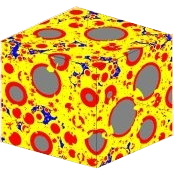
Terimler ve Tanımlar

TANIMLAR

Weighted maturity (Rg) : The sum of the products of hardening times and concrete temperatures over fixed measurement intervals, taking into account the effect of the temperature sensitivity of the binding agent.
Concrete temperature : The temperature of the concrete at a random time during hardening of the concrete.
Binding agent factor k : The factor by which the quantity of filler with a binding agent function (v) is multiplied(This definition is has been taken unchanged from NEN 5950).
C value : The factor in the calculation of the weighted maturity that shows the effect of the temperature sensitivity of the binding agent.
Calibration graph : The graph that for a particular concrete composition shows the compressive strength as a function of the logarithm of the weighted maturity.
Process standard deviation : The standard deviation corresponding to the production site of at least 30 compressive strength figures of a maximum of 1 year old, of commonly occurring concrete compositions.
Regression line : The graphical presentation of a function derived by linear regression, from spreading points.
Calibration line : The line in the calibration graph, parallel to the regression line that has shifted to lower compressive strengths in a vertical direction over a previously agreed distance.
Thermostatic bath : A water bath with an evenly distributed, regulated temperature distribution.
Determination of weighted maturity : Measure the concrete temperature at the selected measurement points, at least three times per hour, starting after compaction of the concrete. Then calculate on the basis of the course of the concrete temperature over time and the C value of the binding agent, determined according to Annex A (where applicable stated by the supplier of the cement or the binding agent, but then also determined according to Annex A: see the foreword), the weighted maturity according to Annex B.
Determination of the calibration graph : The calibration graph shows the relationship between the weighted maturity and the compressive strength of one particular concrete composition. If the weighted maturity of the concrete in a structure is calculated on the basis of the measured concrete temperatures and hardening times, the corresponding anticipated compressive strength can be read off from the calibration graph of the concrete composition used.
Determination of the C value : In the "weighted maturity" method the C value is the factor that in the calculation shows the effect of the temperature sensitivity of the binding agent. The higher the C value, the more the compressive strength is affected by the concrete temperature. With the determination of the C value of a binding agent the effect of the concrete temperature on the compressive strength is established. This is done by making test specimens of the same composition, having these cured at different temperatures and determining the compressive strength at different times. Time and temperature are converted to maturity so that for each temperature the compressive strength can be shown as a function of maturity. The C value of the binding agent is the numerical value for which: the same maturity is the same compressive strength.
Calculation of the weighted maturity :
Rg = 10 (C(0,1T - 1,245) – C(-2,245)) / ln C
Rg = Weighted maturity in one hour [ °C.h ]
T = Average temperature in that hour [ °C ]
C = C-value (weighting factor) of the used cement
The weighted maturity shall be calculated on the basis of measurement intervals of a maximum of 1 h.
Determination of compressive strength : Determine from the calibration graph (see clause 6) the compressive strength of the concrete corresponding to the measured weighted maturity.
